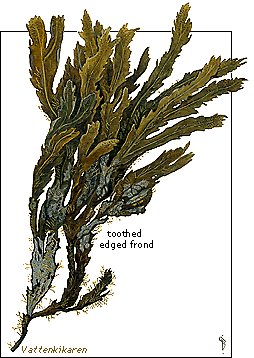|

Distribution in scandinavian waters
|
Maximum length: Toothed wrack can be up to 1 m
tall.
Appearance: The edges of the leaf-like body are saw-toothed.
Toothed wrack is flat and has a fan-shaped form. There is a visible
nerve in the middle of the lobes. The leaves (fronds) are devoid of
air filled bladders, but on occasions the upper most part of the frond
can became oxygen filled. Its colour can vary from a yellow-green to
dark brown.
Depth: Along the Swedish westcoast they can be dominant in banks
from low
water and to a depth of 4 m. In the Baltic,
dense populations can be found down to about 15 m.
Environment: Found on rocks
and cliffs.
Misc: The plants are single sexed. The granular and flat receptacles
(reproductive organs) form at the top of the shoots during the late
summer, and reproduction takes place from the winter and into the spring.
When the receptacles have fulfilled their task, both they and the shoots
wither and die. Read more about the biology of the bladder
wrack.
Many
organisms thrive on toothed wrack. The dark patches seen on the
above pictured plant are ectoprocts (small moss-like creatures), sea-mats,
while the small sparse ”bushes” are hydroids.
Classification: Toothed wrack is a member of the
brown algae group.
|


